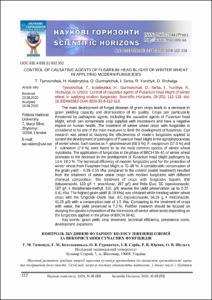Please use this identifier to cite or link to this item:
http://elar.tsatu.edu.ua/handle/123456789/19485| Title: | Контроль збудників фузаріозу колосу пшениці озимої за використання сучасних фунгіцидів |
| Other Titles: | Control of causative agents of fusarium head blight of winter wheat in applying modern fungicides |
| Authors: | Тимощук, Тетяна Миколаївна Tymoshchuk, Tetyana Котельницька, Г. М. Kotelnytska, H. Гурманчук, О. В. Gurmanchuk, O. Серба, І. В. Serba, I. Юрчик, Р. В. Yurchyk, R. Шульга, О. В. Shchulga, O. |
| Keywords: | урожайність зерна;обробка посівів;технічна ефективність;бал стійкості;розвиток;grain yield;crop treatment;technical efficiency;persistence score;development;expansion |
| Issue Date: | 2020 |
| Publisher: | Scientific Horizons |
| Citation: | Контроль збудників фузаріозу колосу пшениці озимої за використання сучасних фунгіцидів / Т. М. Тимощук., Г. М. Котельницька., О.В. Гурманчук., І. В. Серба., Р.В. Юрчик., О. В. Шульга // Наукові горизонти. Scientific Horizons. 2020, №8(93). С. 112–118. DOI: https://doi.org/10.33249/2663-2144-2020-93-8-112-118. |
| Abstract: | UA: Масовий розвиток грибних хвороб зернових культур призводить до зниження урожайності зерна та погіршення його якості. Особливу загрозу посівах становлять патогени, у тому числі і збудники фузаріозу колоса, які здатні забруднювати рослинницьку продукцію мікотоксинами та виявляти негативний вплив на здоров’я людини. Одним із основних заходів обмеження розвитку фузаріозу колосу є обробка посівів пшениці озимої фунгіцидами. Метою наших досліджень було вивчити ефективність сучасних фунгіцидів для контролю розвитку збудників фузаріозу колосу в агрофітоценозі пшениці озимої. Встановлено, що у видовому складі мікобіоти колосу пшениці озимої найбільш поширеними були види Fusarium graminearum (68,0 %), F. oxysporum (17,0 %) та F. culmorum (7,0 %). Застосування фунгіцидів у фазі ВВСН 59–61 пшениці озимої забезпечує зниження розвитку збудників фузаріозу колоса на 14,4–18,0 %. Технічна ефективність застосування сучасних фунгіцидів у захисті пшениці озимої від фузаріозу колоса пшениці озимої становить 70–88 %. За обробки посівів пшениці озимої сучасними фунгіцидами з різним хімічним складом отримано істотне збереження врожаю зерна – 0,29–0,55 т/га порівняно із контролем (обробка водою). Обробка рослин фунгіцидами Супрім, ЕВ (тебуконазол, 133 г/л + прохлораз, 267 г/л) та Рекс Дуо, КС (епоксиконазол, 187 г/л + тіофанат-метил, 310, г/л) забезпечує збереження врожаю до 0,37–0,41 т/га. Найвищу урожайність зерна (8,19 т/га) отримано за обробки посівів пшениці озимої фунгіцидом Осіріс Стар, КЕ (епоксиконазол, 56,25 г/л + метконазол, 41,25 г/л) з нормою витрати 1,5 л/га. Збережений врожай становить 7,2 % порівняно з обробкою посівів водою. Подальші дослідження слід зосередити на вивченні видового складу мікробіоти насіння пшениці озимої залежно від застосування фунгіцидів у фазі ВВСН 59–61. /// EN: The mass development of fungal diseases of grain crops leads to a decrease in grain yielding capacity and deterioration of its quality. Crops are particularly threatened by pathogenic agents, including the causative agents of Fusarium head blight, which can contaminate crop supplies with mycotoxins and have a negative impact on human health. The treatment of winter wheat crops with fungicides is considered to be one of the main measures to limit the development of fusariosis. Our research was aimed at studying the effectiveness of modern fungicides applied to control the development of pathogens of Fusarium head blight in the agrophytocenosis of winter wheat. Such species as F. graminearum (68.0 %), F. oxysporum (17.0 %) and F. culmorum (7.0 %) were found to be the most common species of winter wheat mycobiota. The application of fungicides in the phase of BBCH 59–61 of winter wheat promotes to the decrease in the development of Fusarium head blight pathogens by 14.4–18.0 %. The technical efficiency of modern fungicides used for the protection of winter wheat from Fusarium head blight is 70–88 %. A considerable conservation of the grain yield – 0.29–0.55 t/ha compared to the control (water treatment) resulted from the treatment of winter wheat crops with modern fungicides with different chemical composition. The treatment of crops with fungicides Suprim, EW (tebuconazole, 133 g/l + prochloraz, 267 g/l) and Reks Duo, SC (epoxiconazole, 187 g/l + thiophanate-methyl, 310, g/l) ensures the yield preservation up to 0.37– 0.41 t/ha. The highest grain yield (8.19 t/ha) was obtained while treating winter wheat crops with the fungicide Osiris Star, EC (epoxiconazole, 56.25 g + metconazole, 41.25 g/l) with a consumption rate of 1.5 l/ha. Comparing to the treatment of crops with water, the yield preserved is 7.2 %. Further research should be focused on studying the species composition of the microbiota of winter wheat seeds depending on the fungicides applied in the phase of BBCH 59-61. |
| URI: | http://elar.tsatu.edu.ua/handle/123456789/19485 |
| DOI: | https://doi.org/10.33249/2663-2144-2020-93-8-112-118. |
| UDC: | 632.4:633.11:632.952 |
| Appears in Collections: | Кафедра Рослинництва та садівництва ім. професора В.В. Калитки |
Files in This Item:
| File | Description | Size | Format | |
|---|---|---|---|---|
| Tymoshchuk_control.pdf | 524.52 kB | Adobe PDF |  View/Open |
Show full item record
CORE Recommender
???jsp.display-item.check???
Items in DSpace are protected by copyright, with all rights reserved, unless otherwise indicated.
